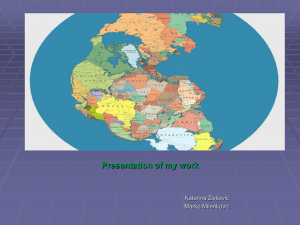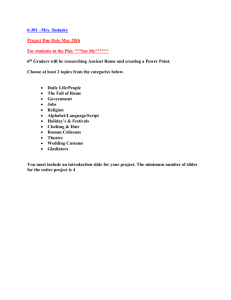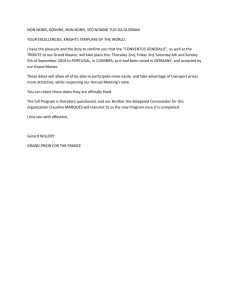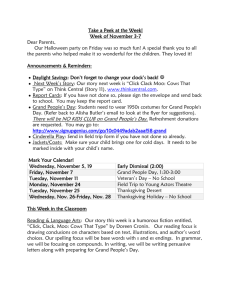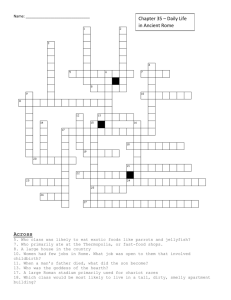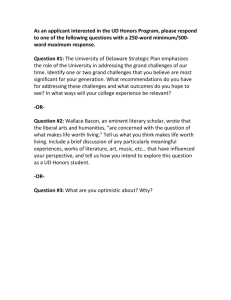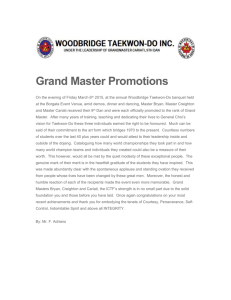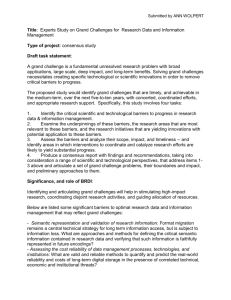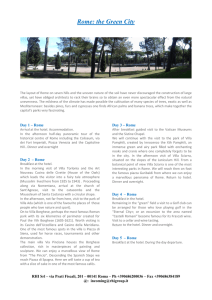Dear Michael, - The Georgian Group
advertisement
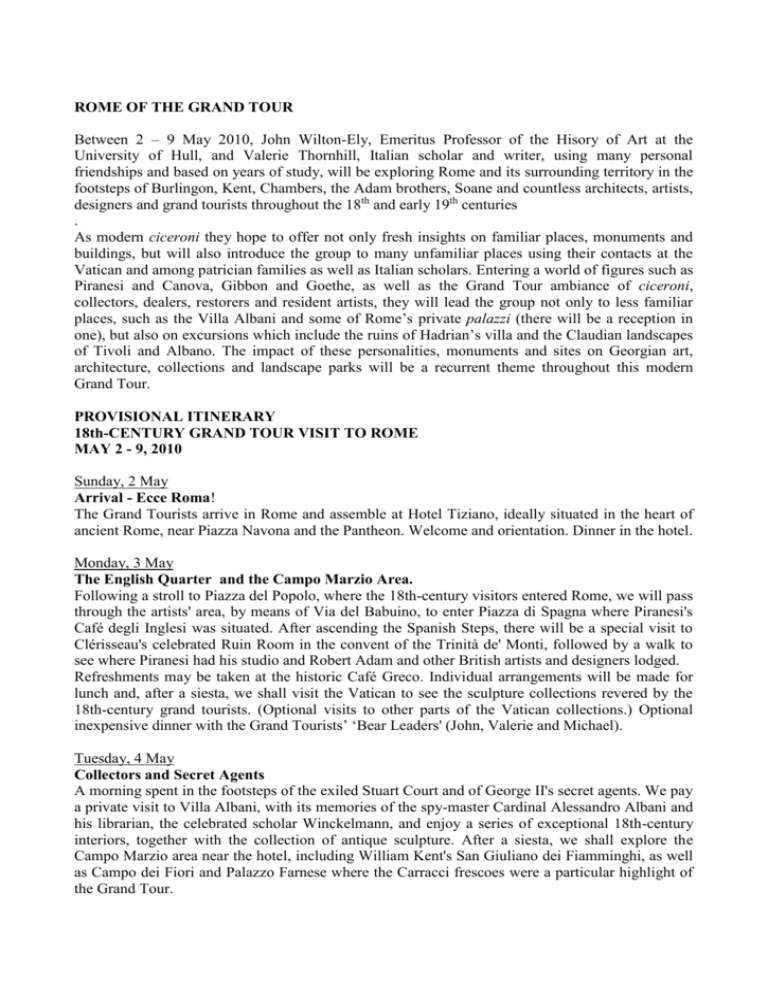
ROME OF THE GRAND TOUR Between 2 – 9 May 2010, John Wilton-Ely, Emeritus Professor of the Hisory of Art at the University of Hull, and Valerie Thornhill, Italian scholar and writer, using many personal friendships and based on years of study, will be exploring Rome and its surrounding territory in the footsteps of Burlingon, Kent, Chambers, the Adam brothers, Soane and countless architects, artists, designers and grand tourists throughout the 18th and early 19th centuries . As modern ciceroni they hope to offer not only fresh insights on familiar places, monuments and buildings, but will also introduce the group to many unfamiliar places using their contacts at the Vatican and among patrician families as well as Italian scholars. Entering a world of figures such as Piranesi and Canova, Gibbon and Goethe, as well as the Grand Tour ambiance of ciceroni, collectors, dealers, restorers and resident artists, they will lead the group not only to less familiar places, such as the Villa Albani and some of Rome’s private palazzi (there will be a reception in one), but also on excursions which include the ruins of Hadrian’s villa and the Claudian landscapes of Tivoli and Albano. The impact of these personalities, monuments and sites on Georgian art, architecture, collections and landscape parks will be a recurrent theme throughout this modern Grand Tour. PROVISIONAL ITINERARY 18th-CENTURY GRAND TOUR VISIT TO ROME MAY 2 - 9, 2010 Sunday, 2 May Arrival - Ecce Roma! The Grand Tourists arrive in Rome and assemble at Hotel Tiziano, ideally situated in the heart of ancient Rome, near Piazza Navona and the Pantheon. Welcome and orientation. Dinner in the hotel. Monday, 3 May The English Quarter and the Campo Marzio Area. Following a stroll to Piazza del Popolo, where the 18th-century visitors entered Rome, we will pass through the artists' area, by means of Via del Babuino, to enter Piazza di Spagna where Piranesi's Café degli Inglesi was situated. After ascending the Spanish Steps, there will be a special visit to Clérisseau's celebrated Ruin Room in the convent of the Trinità de' Monti, followed by a walk to see where Piranesi had his studio and Robert Adam and other British artists and designers lodged. Refreshments may be taken at the historic Café Greco. Individual arrangements will be made for lunch and, after a siesta, we shall visit the Vatican to see the sculpture collections revered by the 18th-century grand tourists. (Optional visits to other parts of the Vatican collections.) Optional inexpensive dinner with the Grand Tourists’ ‘Bear Leaders' (John, Valerie and Michael). Tuesday, 4 May Collectors and Secret Agents A morning spent in the footsteps of the exiled Stuart Court and of George II's secret agents. We pay a private visit to Villa Albani, with its memories of the spy-master Cardinal Alessandro Albani and his librarian, the celebrated scholar Winckelmann, and enjoy a series of exceptional 18th-century interiors, together with the collection of antique sculpture. After a siesta, we shall explore the Campo Marzio area near the hotel, including William Kent's San Giuliano dei Fiamminghi, as well as Campo dei Fiori and Palazzo Farnese where the Carracci frescoes were a particular highlight of the Grand Tour. Wednesday, 5 May The Drama of Picturesque Nature, and the Grandeur of Imperial Ruins :Tivoli No 18th-century visitor to Rome could miss a visit to Tivoli to explore Hadrian's Villa, experience the scenic grandeur of the nearby town's setting, marvel at the invention of the gardens of Villa d'Este and the natural cascades of Villa Gregoriana. This full day visit by coach to Tivoli will include an 'al fresco' lunch at a restaurant in the shadow of the Temple of Vesta which figures in so many paintings and architect's sketches. We return to Rome via Lakes Nemi and Albano, time permitting. Optional inexpensive dinner with the Grand Tourists’ ‘Bear Leaders' Thursday, 6 May Princely Roman Collections A private visit to *the celebrated interiors and art collection of Palazzo Colonna, passing by Palazzo Muti, seat of the exiled Stuart court, on our way to a private visit to Palazzo Mancini, seat of the 18th-century French Academy, returning to the hotel via Trajan's Market. After the siesta there will be a special visit to a patrician palazzo, not open to the public, where we shall be welcomed by a member of one of the Papal aristocratic families. Later, we visit the Casino dell'Aurora Pallavicini with its celebrated ceiling painting by Guido Reni, which inspired interiors in several British country houses. Friday, 7 May The Art World of 18th-century Rome We visit the secluded area of the Aventine* where we shall have a private visit to S. Maria del Priorato, with its delectable gardens and the Knights of Malta's remarkably preserved 18th-century church, restored and magnificently embellished by Piranesi. After the siesta, we shall visit the area of the great 18th-century Fontana di Trevi, with a special visit to its palazzo housing the national print collection. There, in the Calcografia Nazionale, we can examine Piranesi's copper plates and visit nearby the small but choice art collection of the famous artists’ organization, the Accademia di San Luca. Later we pay a private visit to Villa Madama, decorated by Raphael and his school for a Medici cardinal, later Clement VII, and a major inspiration for William Kent and Robert Adam. Saturday, 8 May. There will be a morning visit to the gardens of Villa Medici, (current seat of the French Academy). After a siesta, we shall visit the 18th-century sculpture displays of the Capitoline Museum and survey the Roman Forum from it. Farewell dinner. Sunday, 9 May The Grand Tourists leave Rome IMPORTANT This is a provisional itinerary. There may be changes in the order of visits and alterations to the places visited, since many of these are in private hands and we are being allowed privileged access. One afternoon will be spent in the Vatican to explore the Pio Clementino museum with its 18 thcentury sculpture collections that particularly impresed the Grand Tourists. General considerations There will be some leisurely walking every day. As in the 18th century, we shall be lodged within easy walking distance of the places the grand tourists had travelled long distances to see. The two Italian-speaking ciceroni (tour leaders, John and Valerie) can hail a taxi if required. We will be looking at buildings and works of art, so bring a walking stick or equivalent just in case. May, the favoured month of the 18th-century grand tourists, is pleasantly warm, but there may be showers. Bring a light raincoat or umbrella and a warm jacket or cardigan that can easily be discarded. For these places there will be alternative visits for those who came with Valerie on her 2006 tour. Instead of the Piranesi morning on the Aventine, Valerie will look at Circo Massimo, the church of Santa Maria in Cosmedin (featuring among other things the 'Bocca della Verità') and the nearby Temples of Vesta and Fortuna Virilis. Instead of the tour of Palazzo Colonna, there will be a visit to the comparable art collection in the Palazzo Doria Pamphili.
